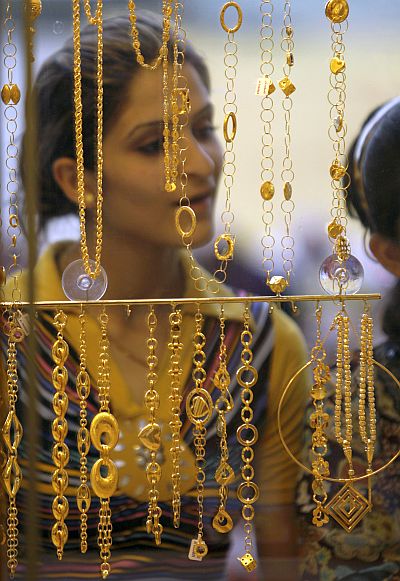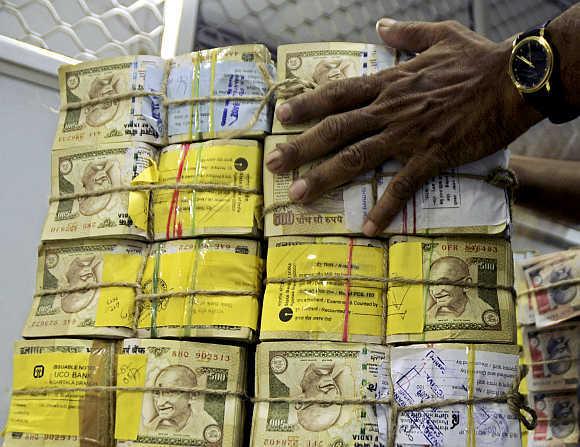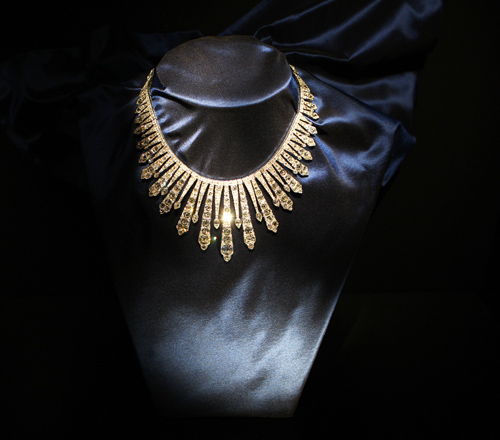Photographs: Saad Shalash/Reuters Indira Rajaraman
At the end of the day, there is only one solution to the gold problem, and that is by offering financial instruments in exchange for the surrender of gold, from which the incremental demand for gold can be met, notes Indira Rajaraman
The external current account deficit remains our biggest worry today.
We closed 2012-13 with a current account deficit at 4.8 per cent of gross domestic product.
That was much too large an asking number for capital account inflows to keep the rupee on an even keel.
Gold imports alone stood at $54 billion, a whopping 61 per cent of the overall current deficit.
Without gold imports, our CAD in 2012-13 would have been a little under two per cent of GDP, a well-behaved and totally tractable level.
So our external problem reduces to the gold problem.
I have written on the urgency of this issue before, when the figures for the previous year, 2011-12, showed gold imports at over 70 per cent of the CAD for that year.
And I am compelled to sound the gold gong yet again.
The vexing issues of gold import and current account deficit
Image: A roadside vendor arranges bread for sale at a market in Kolkata.Photographs: Rupak De Chowdhuri/Reuters
The conversion of the import duty on gold to an ad valorem basis in 2012 was a long overdue structural corrective.
Subsequently, the duty rate on gold has been steadily raised to its present level of eight per cent.
There have also been recent reversals by the Reserve Bank of India of the earlier facilitative role of commercial banks as authorised importers of gold.
These measures over the months of April to May 2013 have already dropped gold imports in June 2013 to 31.5 tonnes, down from a high monthly average of 150 tonnes in April and May.
(Even in the peak year 2011-12, monthly imports averaged at well under 100 tonnes).
It was the Exim Policy for the period 1997-2002 which permitted banks nominated by the Reserve Bank of India to import gold.
. . .
The vexing issues of gold import and current account deficit
Photographs: Reuters
Thirty-six banks were nominated, and in recent years their share had risen to 50 to 60 per cent of gold imports.
Like much of world trade in gold, bank imports were done on a consignment basis.
The importing bank passed on the proceeds of domestic sales to the supplier, and incurred no risk on unsold inventory.
Consignment trade calls for trust between the exporter and importer, and from the supplier’s perspective, a reputed commercial bank was just about the best buyer to engage with.
Banks also engaged in retail sale of gold coins to individual buyers (but that accounted for only two to three per cent of total imports).
. . .
The vexing issues of gold import and current account deficit
Image: A boy sells roses while standing on a road divider during monsoon rains in Mumbai.Photographs: Danish Siddiqui/Reuters
Legitimising gold imports was a part of the reform package in 1991, since pre-reform hostility to gold imports had led to flourishing smuggling and hawala markets, and had kept remittance inflows from Indian workers in the Gulf out of official channels.
The further step of letting banks import gold was a part of that push.
Subsequent to the April 2013 monetary policy restricting gold imports by banks on credit or consignment terms to gold jewellery exporters alone, there have been further restrictions to make the importing of gold procedurally more difficult.
These short-term initiatives are needed at this juncture.
However, in the long term, our appetite for gold has to be examined for what drives it, and we also need to see if it can be fed from a different source than fresh imports.
. . .
The vexing issues of gold import and current account deficit
Photographs: Reuters
Jewellery exports are estimated to account for 16 per cent of imported gold, but that still leaves anywhere from two to three per cent of GDP worth of gold imports going into the domestic sector, steadily over the past four years.
What on earth has it gone into?
The seasonal pattern of peaks during wedding and festival seasons does not tell us the underpinnings of why gold is gifted or hoarded.
It is well known that gold surges as a store of value when financial instruments do not offer a return sufficiently above the rate of retail inflation.
This is borne out by the poor rate of growth of deposit growth at commercial banks today.
Gold also seems to be replacing currency as a medium of exchange in real estate transactions.
. . .
The vexing issues of gold import and current account deficit
Image: A bank employee counts bundles of rupee notes at a cash counter in Agartala, Tripura.Photographs: Jayanta Dey/Reuters
As everyone knows, any real estate transaction can only be closed with a supplementary dose of cash over and above the recorded deal.
Increasingly, the rise in value of real estate transactions seems to have led to the replacement of gold bars for currency in these deals.
Gold bars are less bulky than currency notes to store, and less susceptible to damage than paper.
But there is also a very broad-based demand for gold among ordinary people far removed from real estate transactions, because of the ease with which it can be converted into cash at short notice.
Gold is readily accepted as collateral at non-bank finance company lending windows, with minimal procedural delays.
The increasing privatisation of health and post-school education confronts people with sharp and unpredictable payment spikes.
. . .
The vexing issues of gold import and current account deficit
Photographs: Reuters
Even for those with access to bank loans, gold can be pledged for a bridge loan while a bank application is being processed.
Gold essentially plays the role of a pre-paid credit card.
In the long term, this role of gold can only be curbed if insurance companies develop an effective outreach business model, whereby event insurance is obtainable as easily as at an NBFC window.
Even so, the role of gold as a friction reducer in the financial system may persist for a long time.
At the end of the day, there is only one solution to the gold problem, and that is by offering financial instruments in exchange for the surrender of gold, from which the incremental demand for gold can be met.
The stocks of privately-held gold in India are estimated conservatively at 20,000 tonnes (they could be twice that).
We should aim to offer financial instruments sufficiently attractive that gold held privately or by institutions will be surrendered to the extent of some if not all of annual import demand.
Already, scrap gold is recycled to the extent of 300 tonnes every year.
If this could be nudged up to the point where it meets most of the amount presently imported, which peaked at 1,067 tonnes in 2011-12, gold would need to be imported only for the purposes of re-export as gold jewellery, which is as it should be, and wholly sustainable.
Indira Rajaraman is a retired professor of economics









article